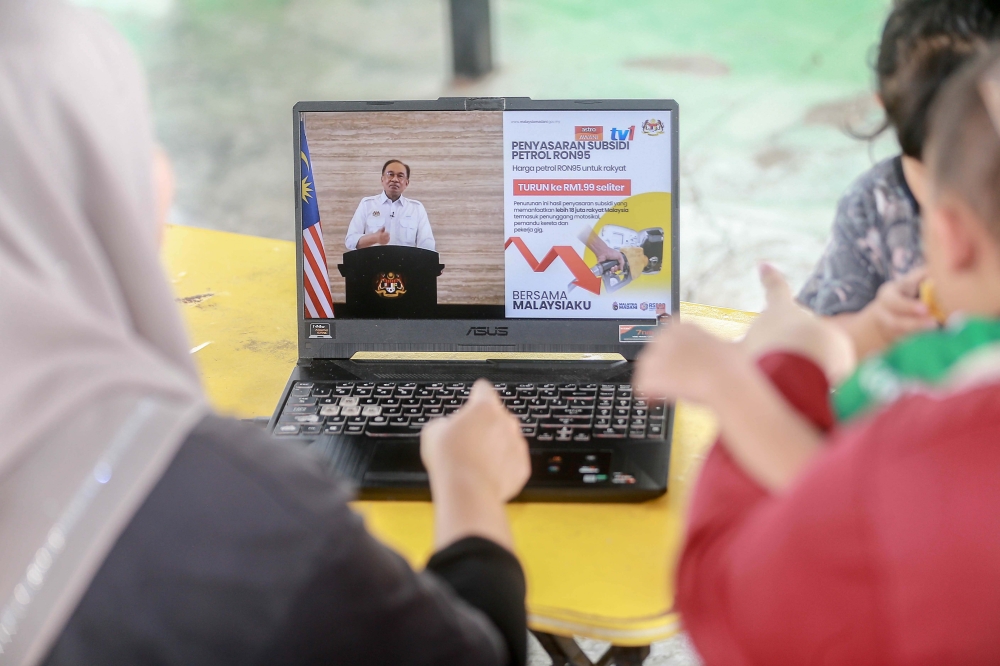JULY 23 — Let’s face it. With or without a tariff from US, pegged at 25 per cent or lowered potentially to 19 per cent, Malaysia has to negotiate the tax down to zero in order to make our export sectors competitive.
This is the formula of Indonesia, the Philippines and Vietnam; which is also aspired by Thailand.
In other words, bite the bullet of Trump’s tariffs on August 1 or after, but lock the Trump Administration in a perpetual negotiation to take the tariff down to zero.
Not unlike how Malaysia’s Semi Conductors and integrated circuits are exempted completely from any Trump tariffs.
In this context, Prime Minister Anwar Ibrahim’s speech to Malaysia was extremely important.
On 23 July 2025, Anwar delivered a detailed account of Malaysia’s economic progress, supported by a catalogue of impressive statistics.
The 4.4 per cent GDP growth in Q1 2025, a projected 4.5 per cent in Q2, and a meteoric rise of 11 places to 23rd in the World Competitiveness Index are not easy to achieve, especially when the US and Chinese economies are locked in a trade war.
As and when Anwar takes a more confident outlook, this underscores an administration working with clear intent and focus.
Yet, among all the indicators, one stands out as the most consequential for long-term national resilience: the strengthening of the Ringgit.
In the past year, the Ringgit has appreciated over 5 per cent, placing it among Asia’s top five performing currencies.
Even though the Ringgit was Asia’s best currency in 2024. Sino-US turbulence has affected Ringgit as much as it has rocket Singapore Dollar too this year.

As and when Anwar takes a more confident outlook, this underscores an administration working with clear intent and focus. — Picture by Sayuti Zanudin
It was Jeff Friedman, a leading Professor of Economics at Harvard, who affirmed: “When all figures are too difficult to compute, focus on the currency. Just the currency.”
By this token, Ringgit is a structural cornerstone of Malaysia’s fiscal independence, investor confidence, and people’s purchasing power.
A strong Ringgit cushions the economy against imported inflation, especially in a world where commodity prices are volatile and geopolitics is increasingly zero-sum.
A strong Ringgit lowers the cost of food imports, medical supplies, industrial components, and educational materials— all of which directly impact the cost of living.
Indeed, while initiatives such as raising the minimum wage hike to RM1,700 — parallel to the living wage policy for 153,000 GLIC/GLC workers, and the targeted RON95 subsidy — are all critical, they are vulnerable to external shocks too.
That is, if the Ringgit is forever weak. But the Ringgit remains strong, which is why Anwar puts it at the start of his speech.
The rest were the icing on the cake. Ringgit Malaysia, for lack of a better word, was the cake that could help the Malaysian economy to grow. When the Ringgit is strong, no credit rating agencies dare to lower our National Credit Ratings. Not by Fitch. Let alone by Moody’s and Standard and Poor’s.
Alternatively, when the Ringgit falters, every gain in wages is offset by higher prices of essentials. Malaysians can’t even travel to Thailand or anywhere in Asean writ large.
In turn, inflation would quietly erode lol purchasing power, especially among the B40 and M40 who do not hold dollar-denominated assets at all.
Moreover, Malaysia’s record-high approved investments of RM384 billion in 2024 (+17 per cent YoY) will only translate into real economic dividends if the currency holds strong. No FDI will flow in if the value of RM is highly questionable in the short and long term.
Foreign direct investors seek not just opportunity, but also currency stability to preserve the value of their returns.
In this regard, the Ringgit’s performance is the ultimate litmus test of macroeconomic credibility.
A strong Ringgit also allows Malaysia to hold its ground diplomatically and economically in increasingly transactional trade negotiations.
As President Donald Trump prepares to impose 25 per cent baseline tariffs on imports from countries such as Malaysia, a robust currency offers some insulation.
Ringgit acts as an internal buffer against price hikes on strategic imports—especially on food, fuel, fertilizers and animal feed.
A fragile Ringgit under these conditions would further delay investments in high-tech clusters like Johor-Singapore’s data processing corridor. In turn, eroding trust in Malaysia’s medium-term economic outlook.
Furthermore, domestic fiscal policy can be more targeted when the Ringgit is strong. Cash aid can be meted out, no matter how minute, as Anwar did.
Without currency stability, such cash transfers risk triggering demand-driven inflation, thereby undermining the very goal of cost-of-living relief.
Similarly, the doubling of Rahmah Sales to RM600 million across all 600 state constituencies will only succeed in easing household burdens if supply chains remain unshaken by currency fluctuations.
The government’s decision to postpone toll rate hikes—absorbing RM500 million in compensation—and the maintenance of the RON95 petrol price at RM1.99 per litre is a salving grace. But these measures would not be possible if the Ringgit is weak. Say, at RM 4.70 to USD 1.
Invariably, a strong Ringgit mirrors the electricity subsidy model; all depend heavily on a firm currency footing. Otherwise, the government will find itself locked in a losing game of chasing subsidies amid a depreciating exchange rate.
What is more, even Malaysia’s noble efforts in poverty eradication—150,000 hardcore poor households lifted out of poverty—can be reversed if inflation rises due to currency depreciation. Once again, Ringgit plays a pivotal role.
While fiscal transfers under STR and SARA (RM15 billion combined) and JKM aid (RM2.9 billion) are critical, the medium-term efficacy of these programmes rests on stable pricing for essentials, which in turn depends on the Ringgit.
In short, Malaysia can no longer afford to treat the Ringgit as a passive indicator. It must be made the centerpiece of strategic planning.
Bank Negara Malaysia and the Ministry of Finance must synchronize monetary and fiscal policy with foreign investment flows, ensure minimal capital flight, and enhance Ringgit-denominated savings and bond issuances.
The goal is to make the Ringgit a trustworthy store of value not just for Malaysians, but for Asean partners and regional investors.
The message from Anwar Ibrahim is clear: “the people, the people, the people.” But to protect the people from future shocks—from tariff wars to food crises—Malaysia must now pivot to “the Ringgit, the Ringgit, the Ringgit.”
A dignified life for all Malaysians begins not only with job creation and subsidies, but with a stable and respected national currency. The foundation has been laid. It is time to build.
* Phar Kim Beng is a professor of Asean Studies and director of the Institute of Internationalization and Asean Studies at the International Islamic University of Malaysia
** This is the personal opinion of the writer or publication and does not necessarily represent the views of Malay Mail.






